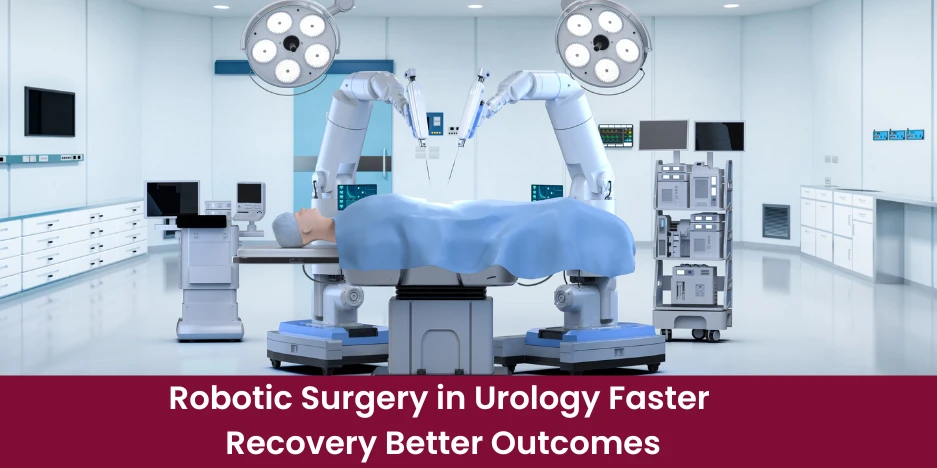In innovative medical science, robotic surgery has emerged as a game-changing technique. For urology, robotic surgery is reshaping the way urologists approach complex operational procedures. Instead of making large cuts, the robotic urologist surgeon uses cutting-edge robotic tools to perform the surgery through minimal incisions in the body.
While robotic surgeons get the advantage of utilizing advanced robotic systems to operate, patients are even more benefited with better results, like faster recovery and less pain.
Dr Rajesh Taneja, a highly experienced robotic urologist surgeon in Delhi, utilizes the latest robotic technology for minimally invasive surgery that can lead patients to faster recovery times.
Let’s find out what robotic surgery in urology entails, what its numerous benefits are, and why it has become a preferred treatment choice for both surgeons and patients.
Understanding Robotic Surgery
Robotic surgery doesn’t mean replacing surgeons; it’s about assisting them to enhance their surgical performances. Utilizing highly advanced robotic systems, a 3D HD imaging camera and robotic arms are inserted. The entire procedure is controlled by an experienced robotic surgeon. Once the 3D camera provides an immersive 3D view inside the surgical site, the robotic arms act as the surgeon’s hand movement but with more steadiness and better range of motion to perform the delicate surgery.
Why in Urology?
Urology focuses on the treatment of diseases related to the urinary system and male reproductive organs. The treatment often requires delicate surgeries with optimal precision. From prostate cancer treatment to kidney stone removal – urologists perform various challenging surgeries where they can’t afford to make a minor mistake. At this place, robotic surgery makes a world of difference for a robotic urologist surgeon.
Benefits of Robotic Surgery in Urology
Due to its wide-ranging benefits, robotic surgery has been massively adopted in urology. Let’s find out some of its significant advantages –
1. Minimally Invasive Approach
One of the significant advantages of robotic surgery is its minimally invasive approach. Since most urologically issues involve operating in complex areas, such as the prostate, kidneys and bladder, the minimum invasiveness helps avoid damaging surrounding tissues, blood vessels, and nerves.
For prostate cancer, an expert uro oncologist in Delhi can perform the surgery with a robotic-assisted method with an edge to enhance precision. With the assistance of the robotic arms, the surgeon operates in complex and confined areas in the body, which can significantly reduce the patient’s trauma and speed up recovery times.
2. Reduced Risk of Complications
The enhanced precision and minimal invasion achieved through robotic technology reduces the risk of surgical complications such as excessive bleeding, infections and damage to the surrounding tissues and organs.
3. 3D Visualization and Magnification
With the robotic camera inside, a skilled robotic urologist surgeon in Delhi can get a 3D view of the surgical site, allowing them to perceive even the smallest structures with higher clarity. For a urological surgery, clarity and magnification are crucial to see intricate anatomical details to ensure the procedure is flawless.
4. Faster Recovery Time
While a traditional surgery may require the patient to stay in the hospital for a longer time and take months to fully recover, robotic surgery can significantly reduce hospital stays and faster return to normal activities. For patients, this medical advancement is a blessing – especially when they can resume their normal activities faster, in some cases, within a week.
5. Minimum Blood Loss
The precision of the robotic system helps manipulate tissues, which leads to significantly reduced blood loss. Reduced blood loss makes the recovery easier.
6. Less Pain and Discomfort
Patients who undergo robotic surgery often experience less post-operative pain and discomfort. This not only improves the entire treatment of the patient but also decreases the need for pain-reducing medication and its several side effects.
7. Minimized Scarring with Better Cosmetic Results
Due to smaller incisions, scarring is minimal in robotic surgery in urology. Hence, patients can expect better aesthetic results, which also means faster healing and a reduced risk of infection in complicated procedures like prostatectomy and nephrectomy.
Final Thought
With several benefits, robotic surgery is nothing less than a revolution in the urological field. It perfectly combines technological brilliance and the medical expertise of the robotic urologist surgeon that can transform surgical complications into more controllable procedures.
With time, robotic technology will evolve more, being more affordable and accessible for everyone in need. Also, robotic surgery does not only mean technological accomplishments, it still depends on the expertise of the surgeon.
If you want to consider this innovative approach for urology and oncological treatment, consult Dr Rajesh Taneja, the best robotic uro oncologist in Delhi. He will be the right person to diagnose and decide if robotic surgery is the right option based on your health needs and conditions.




